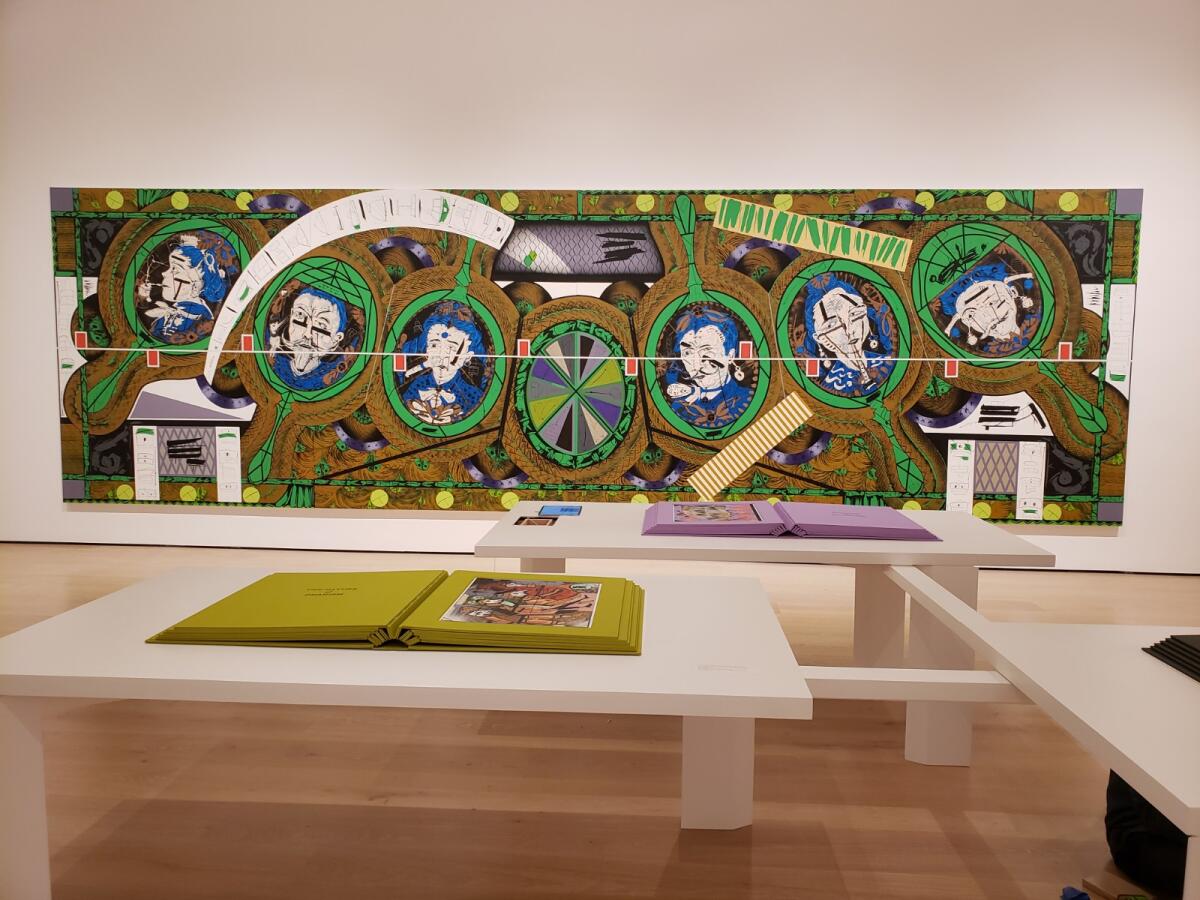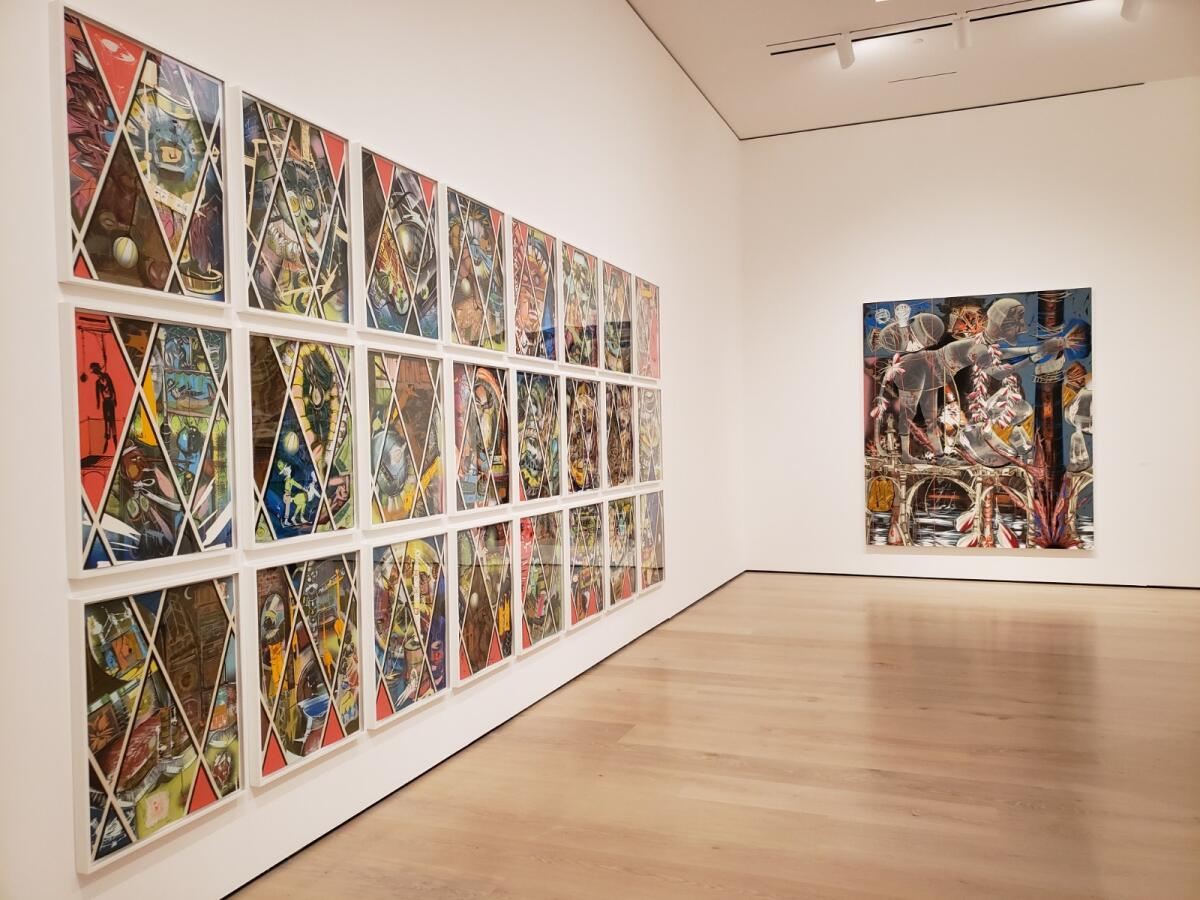Review: Lari Pittman’s extraordinary ‘Declaration of Independence’ at the Hammer Museum
- Share via
Lari Pittman makes the queerest paintings around. He’s been doing it nonstop since 1985.
That was the year he produced an unprecedented series of exceptional paintings and painted sculptures. Their theme, forthright and unabashed, is encapsulated in “Lari Pittman: Declaration of Independence,” the title of his breathtaking new career retrospective at the UCLA Hammer Museum.
For the first time, the Hammer has turned over virtually all its main exhibition spaces to a comprehensive survey of a single artist — a testament to his singular achievement and broad influence. Pittman is Distinguished Professor of Painting and Drawing at the school, but a standard faculty show this is not.
The work’s unsettling emergence is captured in the compressed space of the exhibition’s two small opening rooms. One is tentative, the other definite and assured.
The first features three works that demonstrate outsize ambition and substantial formal range — plus considerable confusion. Made in 1983 and 1984, they are largely abstract.
Bits of figurative imagery do turn up amid the spindly shapes and irregular blocks of color. There are vague suggestions of peering eyes, wispy leaves, brick walls, watery landscapes and odd, bulbous, alien creatures with big, flat feet. They seem for all the world to be the distant cousins of 1982 movie star E.T. the Extraterrestrial.
Pittman, painting on commercial wallpaper applied over 9-foot mahogany panels, stages a fierce embrace of traditional decorative treatments and craft techniques, which he continues to employ today. Crackling, color washing, rag rolling, strié and a variety of other faux finishes rudely intrude on the high-minded vocabulary of Modern abstract art.
One work even sports a shelf, which juts out a foot and a half from the painting’s surface. Two painted-wood objects are carefully placed on top, organic abstraction deployed as a material knickknack. Above the shelf Pittman hung the neatly framed drawing of aliens, transforming his own painting into a living room wall.
But the elements of these first works, made when the artist was just entering his 30s, feel disjointed and rambling. In the second room, everything suddenly snaps into place. The sequence, deftly overseen by exhibition organizer Connie Butler (also responsible for the first-rate catalog) and curatorial assistant Vanessa Arizmendi, hits like a thunderclap.
Pictorial space turns shallow and dark, dominated by a ground of browns, grays and jet black. Shattered networks of looping, dripping, splatted white lines form webs reeking of decay and dissolution. The potential for fecundity in a cellular proliferation lurks amid tangled viscera.
Big, organic blobs of bright blue encompass watery lagoons. The coves and harbors are surrounded by improvisational urban fantasias — dream worlds that are gloomy yet enticing, sometimes festooned with ribbons of human intestinal tracts. On a nearby pedestal, six large dried gourds, their bulbous shapes echoing those big blue blobs, are similarly painted.
Decorated gourds are a vernacular craft throughout Latin America (Pittman is Colombian American). Each is labeled with a single word in flamboyant painted script: charity, compassion, faith, forgiveness, hope and kindness.
The paintings are titled in disarmingly patriotic terms, including “The New Republic” and “Plymouth Rock.” Because the imagery shuns flag waving, instead weaving solemnity, decay and even violence into the mix, these words assume the urgent quality of a demand in the face of dissolution. Sincerity overwhelms possible mawkishness.
Is there a more dismissive or withering insult for art than to call it decorative? Like gay people who later embraced “queer” to defuse the denigration, Pittman’s full-throated demand is for inclusion. Homosexual, he asserts for himself and his art unfettered access to any and every aspect of America’s tattered promise. And he does it on his own terms, which embrace the simple virtues emblazoned on the painted gourds.
Decorative in the extreme, the work strides into areas of life cordoned off in the malignant, mid-1980s repressions of the metastasizing Reagan era, when the ballooning AIDS crisis was greeted with ignorance and indifference. Yet, neither is the era’s art world let off the hook.
Largely hostile to painting, except when it represented the culture’s masculinist delusions typified in the hubbub around Neo-Expressionism, art’s prejudicial establishment gets rebuffed. The personal is fused with the political, terms inseparable in the second-wave feminism on which Pittman feasted in the 1970s while first an undergraduate, then a graduate student at the California Institute of the Arts. The fusion replaces the confusion of the earlier work.
The sudden transformation had unsolicited help.
On July 2, 1985, Pittman was awakened in the middle of the night by an intruder to his Silver Lake apartment. In a flash, he was shot twice in the gut. A thoroughly random act of unspeakable, life-threatening violence, erupting on the brink of Independence Day in a country whose history is riddled with more focused brutalities, concentrated the artist’s mind.
This is where it is necessary for me to disclose the close friendship, including among our respective spouses, that I have developed with the artist over more than 30 years. It began with my dropped-jaw admiration for these 1985 paintings. So make what you will of my eager enthusiasm for the smashing retrospective, a fervor that is anything but disinterested.
For a long time Pittman declined to discuss the near-deadly episode, determined not to be branded from the outside. Sympathy was never the goal.
Yet, this much is true: When Pittman got shot, his art launched into the stratosphere.
There was certainly no guarantee. When Andy Warhol got shot, it brought an abrupt halt to an intense period of groundbreaking art, from which the artist never fully recovered. But once Pittman’s mature work took off in 1985, it never let up. Prepare to be bowled over as the show unfolds.
Of this I am also certain: Decoration is the reason why.
Pittman’s work is often discussed in terms of its radical commitments to adornment. Spectacular gardens, decorated eggs, blue and white porcelains, Dutch still lifes and Spanish interiors, ladies and gentlemen taking tea in drawing rooms — the list is endless, stuffed into jam-packed paintings. Many if not most images are domestic, which he proudly pushes into grand (and even grandiose) public displays.
Several paintings assume the extravagant scale of murals, capped by three mammoth “Flying Carpet” works, each 10 feet high and 30 feet long. Not incidentally, their romantic scenes of misty moons and magic mirrors are riddled with shadows of bullet holes, hangman’s nooses

and the crosshairs of rifle scopes. Diego Rivera parading on the revolutionary public stage meets Frida Kahlo daubing flowers and fashion at home in the Casa Azul.
Others are illuminated manuscripts — not personal prayer books for private meditation, but big, outsize tomes in elaborate and colorful bindings, the kind that might command a communal choir. They’re laid out on three-legged reading tables, at once visually wobbly and miraculously floating, designed in collaboration with architect Michael Maltzan.
Rather than one-dimensional agitprop, Pittman’s paintings offer complex states of agitated being. (Trauma is never fully assuaged.) At once sweet, sour and spicy, the flavor is Pachamama — ancient Andean goddess of immovable mountains, who also delivers earthquakes.
The imagery commanding this visual overload is densely layered. Sometimes it’s accompanied by shouting text and florid punctuation.

A floral garland wraps the neck of a blank-faced man on a bridge, bent over and lashed to a post. He’s a secular Christ at the Pillar, the private passion of a tortured human journey lavished with public regard.
Owls are an ancient Mesoamerican symbol for the dangers of the night, plus a modern logo for Sanborn’s, a cheery restaurant chain that’s a kind of Mexican Denny’s plus general store. The feathered breasts of Pittman’s owls sport gaping birth canals.
In the big, spectacular still life, “Untitled #8 (The Dining Room),” sharp spines protect a domesticated desert cactus, elegantly potted in a porcelain bowl. Pittman paints those spiky thorns as if they’re an intense shower of glistening stars or festive fireworks. The whirling still life is a vibrant celebration of care and comfort within household life.
Perhaps the most familiar of his devices is the cut-paper black silhouette. A debonair, colonial-era art form practiced mostly by young women, the silhouette’s capacity for visual trouble gets pushed by Pittman to overturn decorum, later inspiring the marvelously rude work of artist Kara Walker. Elegantly attired gentlemen wield enormous phallus-swords, while genteel ladies attend to their embroidery, diligently making art.
In the silhouette-studded paintings, the high Modernism of Matisse’s jazzy late paper-cutouts meets the vernacular modernity of menu embellishment at Café de Tacuba, a famous eatery in a former convent in Mexico City’s historic core. The restaurant, notably founded in 1912 as the country’s revolution was exploding, is revered as an exuberantly decorated milieu where indigenous, colonial and modern traditions buoyantly mingle. The graceful black silhouette of a bowler-hatted, middle-class gentleman presides over the menu’s listed fare.
The labor-intensive quality of Pittman’s paintings, which emerged into prominence just as many other artists moved toward outsourced fabrication and ateliers with legions of studio assistants, is on staggering display in the 141 often over-the-top pictures filling the Hammer. Works of art celebrate an individual’s work. For if decoration is to be honored, then its inherent handcraft must be at center stage.
And therein lies the greater, more profound meaning of decoration, which occupies the foreground of this extraordinary show. To decorate is to honor. Ask any battle-scarred survivor who gets a ribbon pinned to his chest or a trophy to adorn her mantel. In Pittman’s declaration of queer independence, decoration is defused as an easy slur.
'Lari Pittman: Declaration of Independence'
Where: UCLA Hammer Museum, 10899 Wilshire Blvd., Westwood
When: Tuesdays-Sundays, through Jan. 5
Admission: Free
Info: (310) 443-7000, www. hammer.ucla.edu
More to Read
The biggest entertainment stories
Get our big stories about Hollywood, film, television, music, arts, culture and more right in your inbox as soon as they publish.
You may occasionally receive promotional content from the Los Angeles Times.











